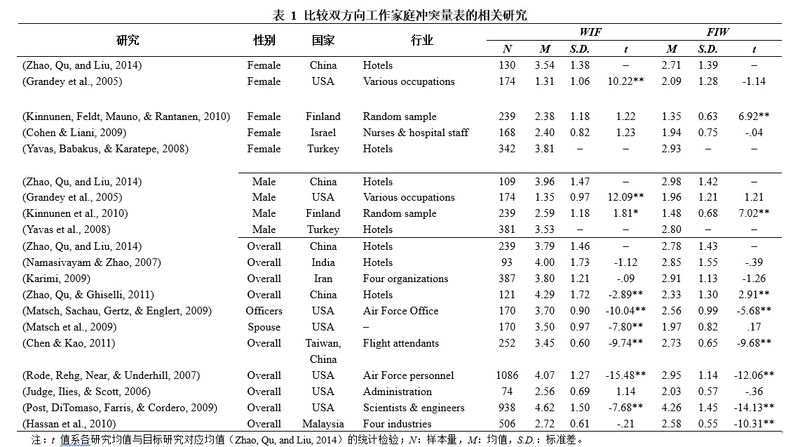Bi-directional Scale of Work-Family Conflict(双方向工作-家庭冲突问卷)

|
|
分享人:赵新元 |
简介
员工工作家庭关系及其组织治理研究自70年代以来,逐渐引起组织行为和人力资源领域的重视(例如:Beigi, Wang, & Arthur, 2017; Hall, 1972; Rizzo, House, & Lirtzman, 1970)。其中,工作家庭冲突由于潜在的负面影响,最早被关注,成为比较典型的研究对象(Greenhaus & Beutell, 1985; Shamir, 1983)。相关研究依据角色理论(Kahn, Wolfe, Quinn, Snoek, & Rosenthal, 1964)、资源保存理论(Hobfoll, 1989)、边界理论(Ashforth, Kreiner, & Fugate, 2000; Clark, 2000)等多来源理论视角,揭示多种内在维度,因此开发出不同量表(例如:Carlson, Kacmar, & Williams, 2000)。其中,Grandey等人(2005)在纵断型研究中,摘取Small和Riley(1990)所开发工作溢出量表的部分问题,聚焦于时间型和精力型,从工作对家庭的影响(Work Interfering with Family;WIF)和家庭对工作的影响(Family Interfering with Work;FIW)双方向,衡量工作家庭冲突,由员工和配偶分别回答。Grandey等人开发的量表长度比较精简,而且内部维度又存在一定变化,适合于研究工作家庭冲突前因后果等内容。
信度与效度
针对酒店业一线服务员工的系列调研数据,来自在珠江三角洲21家高星级酒店所回收的1116份问卷(综合有效回收率=83.1%)。工作对家庭的影响(Work Interfering with Family;WIF):α = 0.774,Composite Reliability (CR) = 0.858,Average Variance Extracted (AVE) = 0.502。家庭对工作的影响(Family Interfering with Work;FIW):α = 0.744,Composite Reliability (CR) = 0.836,Average Variance Extracted (AVE) = 0.533;其中,第11题(反向问题)的因子载荷较低(0.217)。双因素模型的验证性因子分析结果:χ2(31) = 38.933(p = 0.155),GFI = 0.994,AGFI = 0.987,NFI = 0.988,IFI = 0.998,TLI = 0.996,CFI = 0.998,RMSEA = 0.015;各项拟合指数均达到有关标准,支持双因素结构。
量表
请根据您个人的情况回答以下问题,在与您看法最一致的数字上划圈,或打“√”。(1=非常反对,4=既不同意也不反对,7=非常同意) (1)我的工作太忙了,没有时间和我的家人在一起。 (2)下班后,我太累了,常常做不了什么家务事。 (3)工作时间长得经常妨碍我照顾家里。 (4)我下班回到家,经常筋疲力尽,不能承担自己的家庭义务。 (5)我经常加班,回到家干不了多少家务事。 (6)我下班回家,疲惫不堪,做不了家务事。 (7)家务缠身,使我难于做好本职工作。 (8)家务负担太重,限制了我工作的时间。 (9)老是担心家里发生了什么事,使我难于安心工作。 (10)我做完家务后已经很疲倦了,所以没有精力去工作。 (11)我的家庭生活和谐,使我能更好工作。(反向编码)
下载WORD版问卷:文件:BWFI.docx
计分方法
双方向工作家庭冲突问卷包括:工作对家庭的影响(Work Interfering with Family;WIF)和家庭对工作的影响(Family Interfering with Work;FIW)两个分量表,可以计算每个分量表所包括题目的总分或平均分。每个分量表包括的题目如下:
(1)工作对家庭的影响(Work Interfering with Family;WIF):总共6道题项,包括:1 – 6题。
(2)家庭对工作的影响(Family Interfering with Work;FIW):总共5道题项,包括:7 – 11题,其中第11题为反向问题。
研究比较
根据Hassan等人的做法(2010),赵新元等人(2014)比较了使用双方向工作家庭冲突量表(Grandey et al., 2005)的研究结果(下表1)。来自Social Science Citation Index和PsycINFO两个数据库的13项研究曾使用该量表。这些研究的量度都转化到7点尺度。

量表出处
Zhao, X., Qu, H., & Ghiselli, R. (2011). Examining the relationship of work–family conflict to job and life satisfaction: A case of hotel sales managers. International Journal of Hospitality Management, 30(1), 46-54. doi: 10.1016/j.ijhm.2010.04.010
本量表由中山大学赵新元老师提供,在此致谢!
参考文献
Ashforth, Blake E., Kreiner, Glen E., & Fugate, Mel. (2000). All in a day's work: Boundaries and micro role transitions. Academy of Management Review, 25(3), 472-491. doi: 10.5465/AMR.2000.3363315
Beigi, Mina, Wang, Jia, & Arthur, Michael B. (2017). Work–family interface in the context of career success: A qualitative inquiry. Human Relations.
Carlson, Dawn S., Kacmar, K. Michele, & Williams, Larry J. (2000). Construction and Initial Validation of a Multidimensional Measure of Work–Family Conflict. Journal of Vocational Behavior, 56(2), 249-276. doi: 10.1006/jvbe.1999.1713
Chen, Ching-Fu, & Kao, Ya-Ling. (2011). The antecedents and consequences of job stress of flight attendants - Evidence from Taiwan. Journal of Air Transport Management, 17, 253-255. doi: 10.1016/j.jairtraman.2011.01.002
Clark, Sue Campbell. (2000). Work/family border theory: A new theory of work/family balance. Human Relations, 53(6), 747-770. Cohen, Aaron, & Liani, Efrat. (2009). Work-family conflict among female employees in Israeli hospitals. Personnel Review, 38(2), 124-141. doi: 10.1108/00483480910931307
Grandey, Alicia A., Cordeiro, Bryanne L., & Crouter, Ann C. (2005). A longitudinal and multi-source test of the work-family conflict and job satisfaction relationship. Journal of Occupational and Organizational Psychology, 78(3), 305-323. doi: 10.1348/096317905X26769
Greenhaus, Jeffrey H., & Beutell, Nicholas J. (1985). Sources of conflict between work and family roles. Academy of Management Review, 10, 76-88.
Hall, Douglas T. (1972). A model of coping with role conflict: The role behavior of college educated women. Administrative Science Quarterly, 17(4), 471-486.
Hassan, Zaiton, Dollard, Maureen F., & Winefield, Anthony H. (2010). Work-family conflict in East vs. West countries. Cross Cultural Management: An International Journal, 17(1), 30-49. doi: 10.1108/13527601011016899
Hobfoll, Stevan E. (1989). Conservation of resources: A new attempt at conceptualizing stress. American Psychologist, 44(3), 513-524. doi: 10.1037/0003-066X.44.3.513
Judge, Timothy A., Ilies, Remus, & Scott, Brent A. (2006). Work-family conflict and emotions: Effects at work and at home. Personnel Psychology, 59(4), 779-814.
Kahn, Robert Louis, Wolfe, Donald M., Quinn, Robert P., Snoek, J. Suduck, & Rosenthal, Robert A. (1964). Organizational Stress: Studies in Role Conflict and Ambiguity New York, NY: Wiley.
Karimi, Leila. (2009). Do female and male employees in Iran experience similar work-family interference, job, and life satisfaction? Journal of Family Issues, 30(1), 124-142. doi: 10.1177/0192513X08324973
Kinnunen, Ulla, Feldt, Taru, Mauno, Saija, & Rantanen, Johanna. (2010). Interface between work and family: A longitudinal individual and crossover perspective. Journal of Occupational and Organizational Psychology, 83, 119-137. doi: 10.1348/096317908X399420
Matsch, Mahlia A., Sachau, Daniel A., Gertz, Jessica, & Englert, David R. (2009). Perceptions of work-life balance among military law enforcement personnel and their spouses. Journal of Police and Criminal Psychology, 24(2), 113-119. doi: 10.1007/s11896-009-9046-y
Namasivayam, Karthik, & Zhao, Xinyuan. (2007). An Investigation of the Moderating Effects of Organizational Commitment on the Relationships between Work-Family Conflicts and Job Satisfaction among Hospitality Employees in India. Tourism Management, 28, 1212-1223. doi: 10.1016/j.tourman.2006.09.021
Post, Corinne, DiTomaso, Nancy, Farris, George F., & Cordero, Rene. (2009). Work-family conflict and turnover intentions among scientists and engineers working in R & D. Journal of Business and Psychology, 24(1), 19-32. doi: 10.1007/s10869-009-9089-1
Rizzo, J. R., House, R. J., & Lirtzman, S. I. (1970). Role conflict and ambiguity in complex organizations. Administrative Science Quarterly, 15(2), 150-163.
Rode, Joseph C., Rehg, Michael T., Near, Janet P., & Underhill, John R. (2007). The effect of work/family conflict on intention to quit: The mediating roles of job and life satisfaction. Applied Research in Quality of Life, 2, 65-82. doi: 10.1007/s11482-007-9030-6
Shamir, B. (1983). Some antecedents of work-nonwork conflict. Journal of Vocational Behavior, 23, 98-111.
Small, Stephen A., & Riley, Dave. (1990). Toward a multidimensional assessment of work spillover into family life. Journal of Marriage and the Family, 52(1), 51-61. doi: 10.2307/352837
Yavas, Ugur, Babakus, Emin, & Karatepe, Osman M. (2008). Attitudinal and behavioral consequences of work-family conflict and family-work conflict: Does gender matter? International Journal of Service Industry Management, 19(1), 7-31. doi: 10.1108/09564230810855699
Zhao, Xinyuan, Qu, Hailin, & Ghiselli, Richard. (2011). Examining the relationship of work–family conflict to job and life satisfaction: A case of hotel sales managers. International Journal of Hospitality Management, 30(1), 46-54. doi: 10.1016/j.ijhm.2010.04.010
Zhao, Xinyuan, Qu, Hailin, & Liu, Jingyan. (2014). An investigation into the relationship between hospitality employees’ work–family conflicts and their leisure intentions. Cornell Hospitality Quarterly, 55(4), 408-421. doi: 10.1177/1938965513517171
友情提醒
为方便学术研究,根据公开发表的学术成果整理而成,供学者在学术研究中使用, 商业使用请与原作者联系。为了尊重作者的劳动成果, 请根据量表出处规范引用,谢谢!